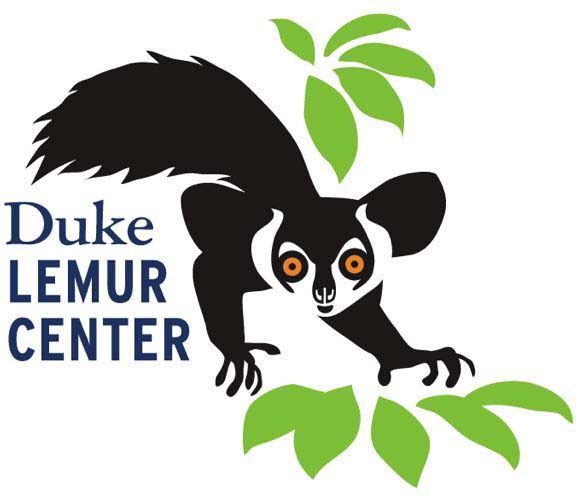
Eulemur flavifrons infant McKinnon, born 3/22/2017, clings to her mother Wiig. In 2015, it was estimated that the blue-eyed black lemur could go extinct in the wild as little as 11 years. Photo by David Haring.
Infants Announced: Two Critically Endangered Blue-Eyed Black Lemurs Born at the Duke Lemur Center
We’re thrilled to announce our newest arrivals: two critically endangered Eulemur flavifrons infants, McKinnon and Poehler!
Both blue-eyed girls were born within a day of one another: McKinnon on March 22 to parents Wiig and Hiddleston, and Poehler on March 23 to West and Quinn.
The blue-eyed black lemur has one of the smallest ranges of any lemur species and is protected in only a tiny area of Madagascar, Sahamalaza National Park. Sadly, because Sahamalaza is susceptible to wildfires and other pressures on the forest, the species is at risk even within the park. Those factors – a narrow geographic range, a single park protecting their natural environment, and a habitat under pressure – have resulted in blue-eyed black lemurs’ CRITICALLY ENDANGERED conservation status. In 2015, it was estimated that the blue-eyed black lemur could go extinct in the wild as little as 11 years due to habitat loss, forest fragmentation, and hunting pressures (Volameno et al.).
There are only four female blue-eyed black lemurs of breeding age in North America. Of these, three reside at the Duke Lemur Center: Margret, Wiig, and West. The fourth, Poots, was born at the DLC but lives at the Los Angeles Zoo with Kilmer, her dark handsome companion. Kilmer, too, resided at the DLC before traveling to Tinseltown.
While we’re elated by the births of these two blue-eyed beauties, we know it’s not enough to care for lemurs only in North Carolina. Not only does the DLC fund major conservation projects in the SAVA (northeastern) region of Madagascar, we’re also assisting Parc Ivoloina in Tamatave, Madagascar (on the island’s eastern coast) with its own blue-eyed black lemur breeding program. The DLC and Parc Ivoloina have worked together since 1987, and Parc employees have received training from DLC veterinarians and staff on-site in Madagascar as well as at the Lemur Center in Durham, NC.
Together, blue-eyed black lemurs at the DLC, Parc Ivoloina, and other institutions worldwide form a genetic safety net for their species. Each new birth helps sustain a healthy and genetically diverse population of blue-eyed black lemurs for the long-term future.
Welcome to the world, McKinnon and Poehler! We’re so happy you’re here!
![]()
Further resources
More great info about the blue-eyed black lemur (Eulemur flavifrons) is available on the species homepage on the DLC website. Information about our breeding program, most recent births, and the AZA’s Species Survival Plans is available here. You’ll also find a gallery of ALL of the DLC’s 2017 infants!
Want to learn even more about blue-eyed black lemurs AND help support their care, not only here but also in Madagascar? Consider symbolically adopting Presley, a male blue-eyed black lemur, through the DLC’s Adopt-A-Lemur program! Adoption packages start at just $50.
For more images of McKinnon and Poehler, keep scrolling! Enjoy!
![]()
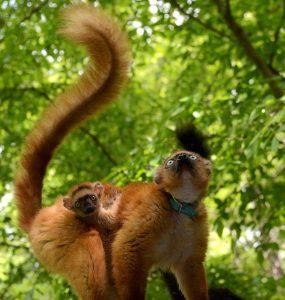
Wiig with one-month-old McKinnon in their forested enclosure. All of the DLC’s blue-eyed black lemurs are named after blue-eyed celebrities, and McKinnon was named after blue-eyed, blonde-haired actress Kate McKinnon. Photo by David Haring.
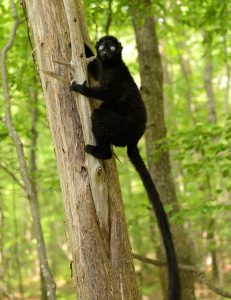
Hiddleston, McKinnon’s father. Blue-eyed black lemurs are the most distinctively sexually dichromatic (different coloration in males and females) of all lemur species. Males are completely black, whereas females are reddish-brown. Photo by David Haring.
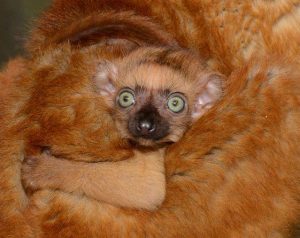
McKinnon. Infants cling to their mothers’ bellies for the first 3 weeks, shifting position only to nurse. At 3-4 weeks of age, the young lemurs will begin to make short explorations of a foot or two away from their mother, quickly scurrying back to the safety of her belly at the first sign of danger. Photo by David Haring.
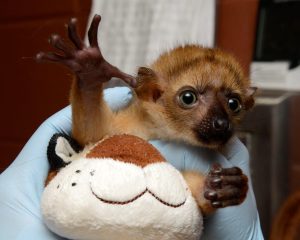
Eulemur flavifrons infant Poehler, born 3/23/2017, is weighed by DLC staff. During their brief time on the scale, infants are given stuffed animals (like this lion) to cling to in their mothers’ stead. Poehler was named after blonde-haired, blue-eyed actress Amy Poehler. Photo by David Haring.
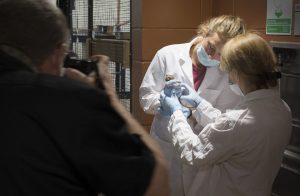
McKinnon, only days old, receives a gentle health examination by DLC staff while National Geographic photographer Joel Sartore (left) looks on. Here, staffers confirm that McKinnon is healthy and strong, able to cling tightly to her mother without risk of falling off; that her body temperature is normal; and that she is gaining weight appropriately, indicating that her mother’s milk is coming in like it should. Examinations are very quick, lasting only a couple of minutes at most. Photo by Sara Clark.
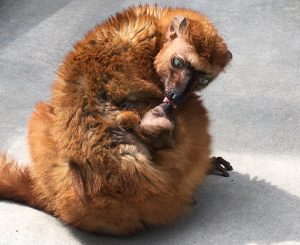
Wiig grooms her infant McKinnon. Photo by Brittany Blackwell, one of Wiig and McKinnon’s primary caretakers.

Poehler snoozes in her mother’s fur. Photo by Matt Cuskelly, one of her primary caretakers.
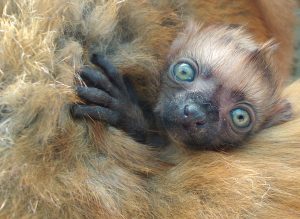
McKinnon, just two weeks old. Photo by Kate Byrnes, one of her primary caretakers.
